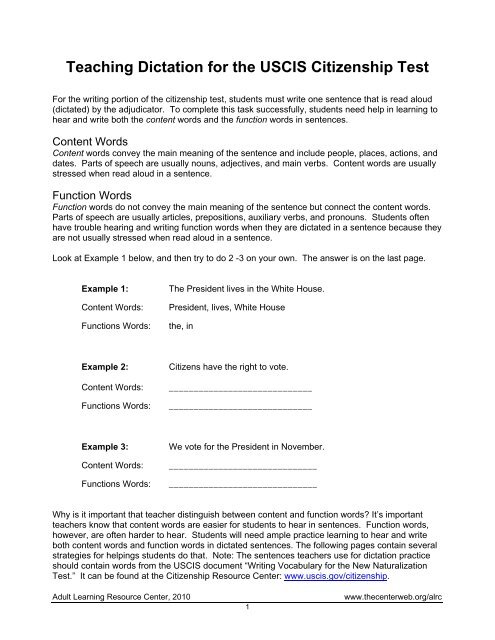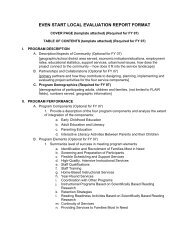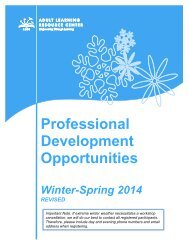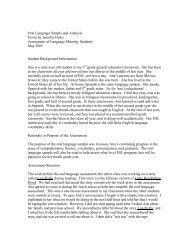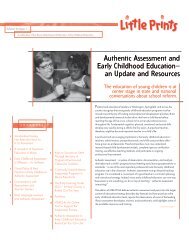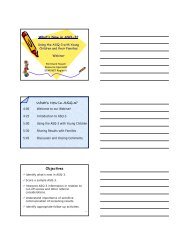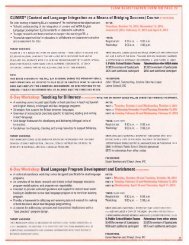Teaching Dictation for the USCIS Citizenship Test - The Center
Teaching Dictation for the USCIS Citizenship Test - The Center
Teaching Dictation for the USCIS Citizenship Test - The Center
Create successful ePaper yourself
Turn your PDF publications into a flip-book with our unique Google optimized e-Paper software.
<strong>Teaching</strong> <strong>Dictation</strong> <strong>for</strong> <strong>the</strong> <strong>USCIS</strong> <strong>Citizenship</strong> <strong>Test</strong>For <strong>the</strong> writing portion of <strong>the</strong> citizenship test, students must write one sentence that is read aloud(dictated) by <strong>the</strong> adjudicator. To complete this task successfully, students need help in learning tohear and write both <strong>the</strong> content words and <strong>the</strong> function words in sentences.Content WordsContent words convey <strong>the</strong> main meaning of <strong>the</strong> sentence and include people, places, actions, anddates. Parts of speech are usually nouns, adjectives, and main verbs. Content words are usuallystressed when read aloud in a sentence.Function WordsFunction words do not convey <strong>the</strong> main meaning of <strong>the</strong> sentence but connect <strong>the</strong> content words.Parts of speech are usually articles, prepositions, auxiliary verbs, and pronouns. Students oftenhave trouble hearing and writing function words when <strong>the</strong>y are dictated in a sentence because <strong>the</strong>yare not usually stressed when read aloud in a sentence.Look at Example 1 below, and <strong>the</strong>n try to do 2 -3 on your own. <strong>The</strong> answer is on <strong>the</strong> last page.Example 1:Content Words:Functions Words:<strong>The</strong> President lives in <strong>the</strong> White House.President, lives, White House<strong>the</strong>, inExample 2:Content Words:Functions Words:Citizens have <strong>the</strong> right to vote.__________________________________________________________Example 3:Content Words:Functions Words:We vote <strong>for</strong> <strong>the</strong> President in November.____________________________________________________________Why is it important that teacher distinguish between content and function words? It’s importantteachers know that content words are easier <strong>for</strong> students to hear in sentences. Function words,however, are often harder to hear. Students will need ample practice learning to hear and writeboth content words and function words in dictated sentences. <strong>The</strong> following pages contain severalstrategies <strong>for</strong> helpings students do that. Note: <strong>The</strong> sentences teachers use <strong>for</strong> dictation practiceshould contain words from <strong>the</strong> <strong>USCIS</strong> document “Writing Vocabulary <strong>for</strong> <strong>the</strong> New Naturalization<strong>Test</strong>.” It can be found at <strong>the</strong> <strong>Citizenship</strong> Resource <strong>Center</strong>: www.uscis.gov/citizenship.Adult Learning Resource <strong>Center</strong>, 20101www.<strong>the</strong>centerweb.org/alrc
Technique #1: How Many Missing Words?This technique helps students learn to hear and write <strong>the</strong> function words in a dictated sentence.Step One: <strong>The</strong> teacher writes a dehydrated sentence (a sentence containing only content words)on <strong>the</strong> board and asks students to copy <strong>the</strong>m on a sheet of paper.For example:President lives White HouseStep Two: <strong>The</strong> teacher <strong>the</strong>n reads <strong>the</strong> complete sentence aloud and asks <strong>the</strong> students to write acaret on <strong>the</strong>ir papers in every place <strong>the</strong>y hear a missing word. <strong>The</strong> teacher should read <strong>the</strong>sentence aloud three times. <strong>The</strong> students write on <strong>the</strong>ir papers:∧ President lives ∧ ∧ White HouseStep Three: <strong>The</strong> teacher has one student come up to <strong>the</strong> board and write <strong>the</strong> carets in <strong>the</strong> correctplaces. When this is correct, ano<strong>the</strong>r student is asked to write <strong>the</strong> complete sentence on <strong>the</strong> boardbelow <strong>the</strong> dehydrated sentence. All <strong>the</strong> students can <strong>the</strong>n copy <strong>the</strong> complete sentence on <strong>the</strong>irpapers.∧ President lives ∧ ∧ White House<strong>The</strong> President lives in <strong>the</strong> White House.Note: Instead of writing <strong>the</strong> dehydrated sentences on <strong>the</strong> board, <strong>the</strong> teacher can prepare aworksheet of several such sentences. After passing out <strong>the</strong> worksheet to <strong>the</strong> class, she proceedswith Step Two, above._____________________________________________________________________________Technique #2: How Many Words?This technique help students learn to hear and write all <strong>the</strong> words (both content and functionwords) in a dictated sentence.Step One: <strong>The</strong> teacher reads a sentence aloud at a normal rate and asks <strong>the</strong> students how manywords <strong>the</strong>y hear. <strong>The</strong> teacher should read <strong>the</strong> sentence aloud three times.Step Two: <strong>The</strong> students respond nonverbally. <strong>The</strong>y can ei<strong>the</strong>r hold up <strong>the</strong>ir fingers to show <strong>the</strong>total number of words <strong>the</strong>y hear or hold up a number fan to show <strong>the</strong> total number of words <strong>the</strong>yhear.Step Three: <strong>The</strong> teacher asks one student to write <strong>the</strong> sentence on <strong>the</strong> board. <strong>The</strong> class correctsany mistakes and determines toge<strong>the</strong>r how many words are in <strong>the</strong> sentence.Adult Learning Resource <strong>Center</strong>, 20102www.<strong>the</strong>centerweb.org/alrc
Technique #3: Scrambled SentencesThis tactile technique helps students review sentences that <strong>the</strong> adjudicator might read aloud <strong>for</strong> <strong>the</strong>writing test.Step One: On <strong>the</strong> board, <strong>the</strong> teacher writes a sentence likely to be read aloud (dictated) at <strong>the</strong>citizenship test.Step Two: <strong>The</strong> teacher gives <strong>the</strong> students several blank index cards and asks <strong>the</strong>m to copy <strong>the</strong>sentence on <strong>the</strong> board onto <strong>the</strong> cards, one word per card. <strong>The</strong> teacher circulates to make surethat spelling and capitalization are correct. It is a good practice to put a period on one of <strong>the</strong> cards.<strong>The</strong> students <strong>the</strong>n put <strong>the</strong> cards into a ziplock baggie or envelope.Step Three: <strong>The</strong> teacher repeats Steps One and Two until each student has a collection of threeto five sentences in bags or envelopes.Step Four: <strong>The</strong> teacher reads one of <strong>the</strong> sentences aloud, and <strong>the</strong> students locate and assemble<strong>the</strong> correct sentence. <strong>The</strong> teacher may need to repeat <strong>the</strong> sentence several times.Note: Students can use <strong>the</strong>ir scrambled sentences <strong>for</strong> individual practice at home or in class when<strong>the</strong>y have a few minutes of free time.______________________________________________________________________________Technique #4: Living SentencesThis kines<strong>the</strong>tic technique is a variation on <strong>the</strong> Scrambled Sentence, above. It helps studentsreview sentences that <strong>the</strong> adjudicator might read aloud (dictate) <strong>for</strong> <strong>the</strong> writing test. It also getsstudents up and moving during long classes.Step One: Be<strong>for</strong>e class, <strong>the</strong> teacher selects several sentences likely to be read aloud (dictated) at<strong>the</strong> citizenship test. She writes one word from each sentence onto a piece of 8 ½ x 11” cardstock.<strong>The</strong> word cards from each sentence are clipped toge<strong>the</strong>r with a paperclip or put into a largeenvelope.Step Two: During class, <strong>the</strong> teacher divides <strong>the</strong> class into groups of 6-10 students. She giveseach group one sentence and asks <strong>the</strong>m to assemble <strong>the</strong> sentence in <strong>the</strong> correct order.Step Three: Working toge<strong>the</strong>r, <strong>the</strong> students arrange <strong>the</strong>ir sentence in order. <strong>The</strong>n groups taketurns coming to <strong>the</strong> front of <strong>the</strong> class to make a “living sentence” by facing <strong>the</strong> class, each studentholding a word card so that <strong>the</strong> sentence is <strong>for</strong>med correctly. If <strong>the</strong>re are more students thanwords in <strong>the</strong> sentence, 2 or 3 students can hold one card.Note: <strong>The</strong> teacher can have <strong>the</strong> class make additional sets of word cards <strong>for</strong> sentences <strong>the</strong>y arestudying. <strong>The</strong> cards can be used <strong>for</strong> 5-10 minutes of review at every class meeting (Steps Twoand Three above).Adult Learning Resource <strong>Center</strong>, 20103www.<strong>the</strong>centerweb.org/alrc


